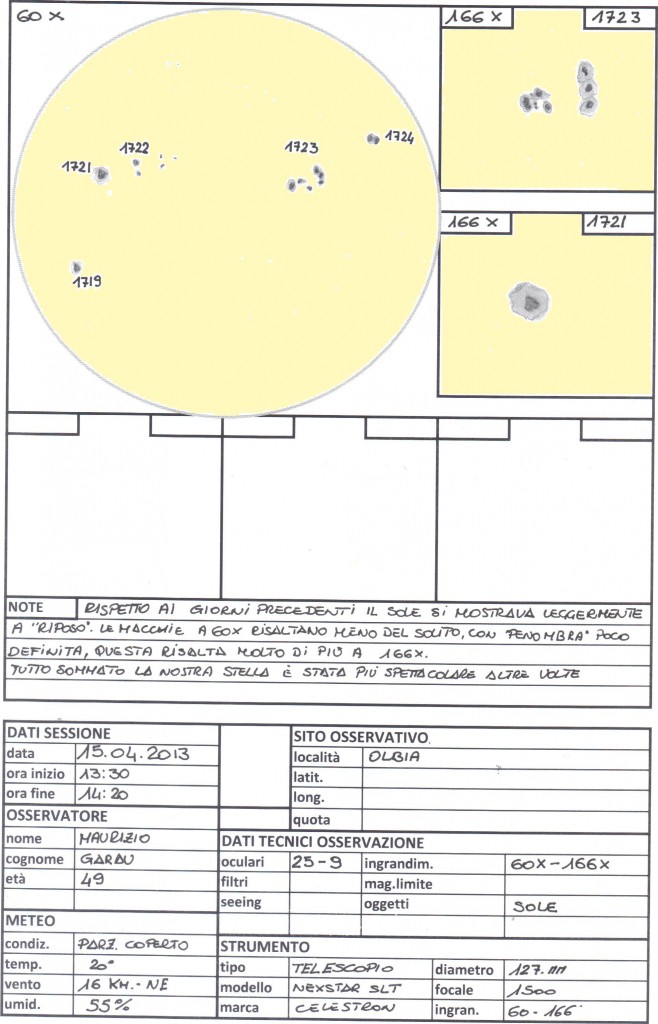
Object Name:Sun.
Object Type: Sunspots
Location: Olbia, Italy
Date: 04/14/2013
Media: graphite pencil ; Paint.
Telescope Celestron Mak 127/1500 with eyepieces 25/9 mm
Filter astrosolar.
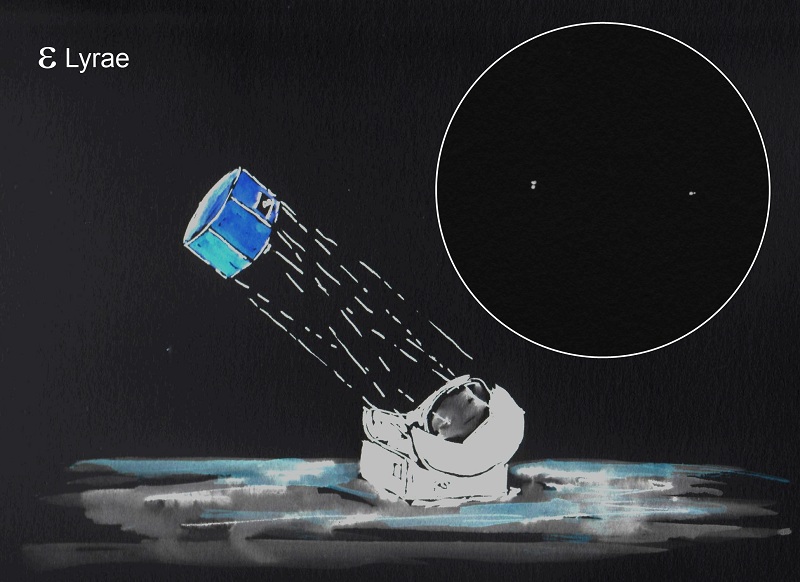
Hello astro-sketchers, here my last contribution…
Object Name (Epsilon1/2 Lyrae the Double double)
Object Type (Multiple Star)
Location (Château de Berne – Provence – France)
Date (May 8th)
Media (watercolor and ink, inverted while scanning)
Epsilon Lyrae, the “double-double” star, seen in the 450mm Dobson of my friend Philippe.
During this 4th yearly animation made in the “Château de Berne”, a nice vineyard domain in Provence, I had the opportunity to sketch this difficult multiple star.
The northern star is called ε1 and the southern one is called ε2; they both lie around 160 light years from Earth and orbit each other. In this big 450mm eye, both stars of the binary can be further split into binaries; that is, the system contains two binary stars orbiting each other. The component stars of ε1 have magnitudes of 4.7 and 6.2 separated by 2.6″ and have an orbital period that can only be crudely estimated at 1200 years, which places them at roughly 140 AU apart. The component stars of ε2 have magnitudes 5.1 and 5.5 separated by 2.3″, orbit perhaps half that period. ε1 and ε2 themselves are not closer than 0.16 light years apart, and would take hundreds of thousands of years to complete an orbit.
I made the watercolor taking into account the further inversion needed, that means black for white and orange for blue, for example.
Astro sketch website : http://astro.aquarellia.com
Clear sky to you all !
Michel Deconinck
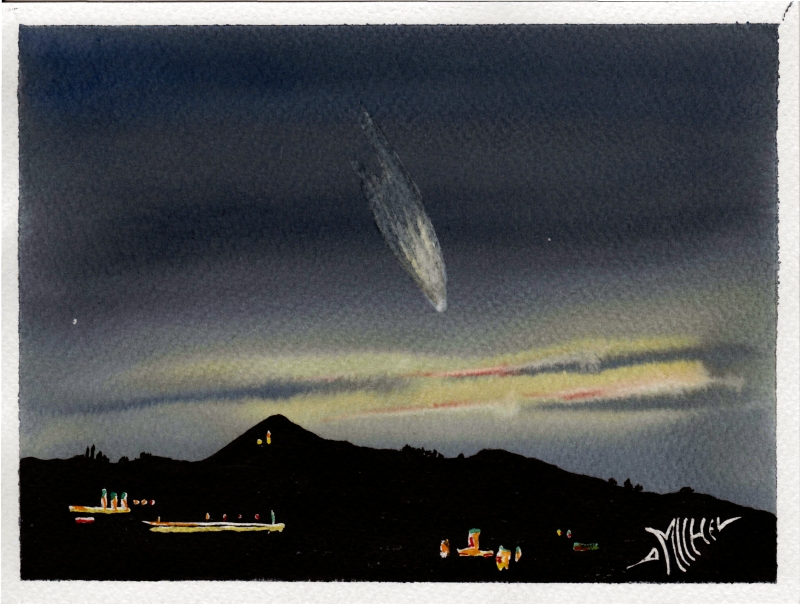
Object Name (2011-L4 PanStarrs)
Object Type (Comet)
Location (Val d’Issole – Provence – France)
Date (2013 March 18th)
Media (Watercolour on 300gr white paper, scan but no digital adaptation)
Hi comet hunters, here follows my contribution.
March 18th, 19:24 UT, from a small hill of the Val d’Issole, I had a nice view of our PanStarrs comet.
It was raining during the first part of the day, but then after a strong “Mistral” wind, the sky was completely cleaned, really pure, just in time for the evening view. I was able to see the tail easily with unaided eye. With a 102/1000 refractor, 25x eyepiece, I made a quick sketch, that was just one minute before the nucleus set followed quickly by the tail. Then at home I made the watercolour. A very nice spectacle indeed!
Michel Deconinck
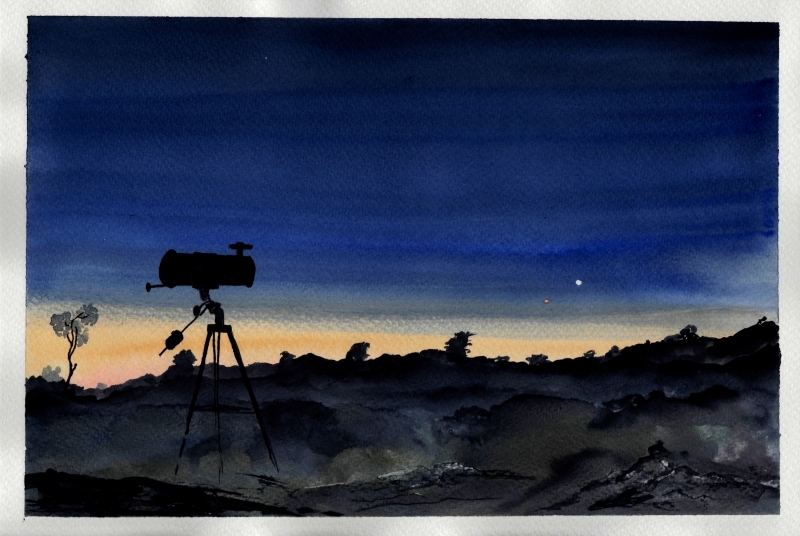
Here join my last watercolour
Object Name (Mars and Mercury)
Object Type (Planet conjunction)
Location (Sainte-Anastasie-sur-Issole, Provence, France)
Date (08-02-2013)
Media (watercolour)
This February 8th between 17h and 18h (UT) I wanted to watch an unusual planets conjunction and set, Mars and Mercury separated by only 15 ‘. This could be seen through the long and wide belt of Venus. I found a peak of 360° free to obstacles – 500 meter altitude. North we see clearly two winter sports resorts and South the Porquerolles Island and its lighthouse – 2 x 10 sec, so… the “M” morse letter, to celebrate our two planets M.. ?
It was cold with a strong wind, I still observed one hour. Some pictures with my little camera and two quick sketches, a complete landscape and an eyepiece vision, in order to be ready to make a watercolour, the day after.
Mercury was bright, clearly visible with a white light. Mars was 8 times less light but very red. No details with my reflector 100/500, plus an eyepiece K12mm. We can just imagine the disc-shaped appearance of the two planets. Mercury was gibbous almost full and very close the tiny and still red planet.
Clear sky to you all !
Michel Deconinck
http://www.aquarellia.com
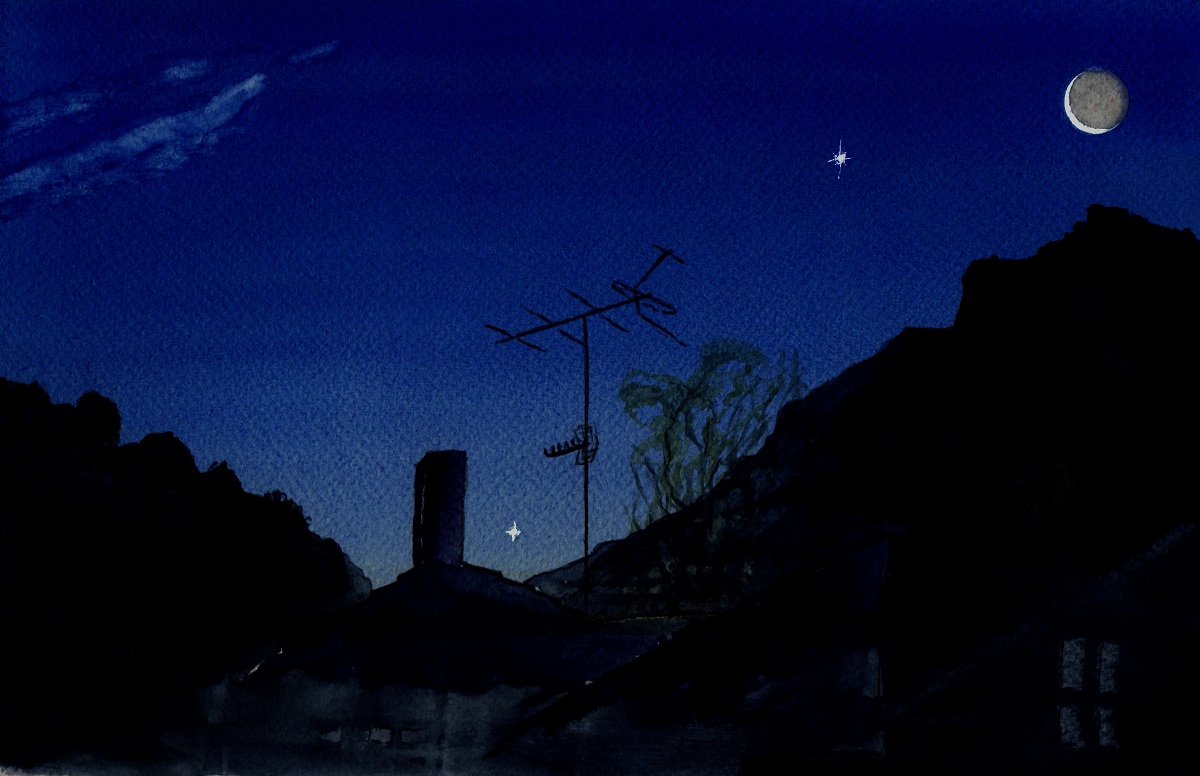
Please find here my (this morning) watercolour
Object Name (Mercury, Venus and the Moon)
Object Type (conjunction)
Location (Rocbaron Provence France)
Date (December 11th 2012 6:00 UT)
Media (Watercolour on 300gr paper plus white colour for planets)
It was quite cold this morning -1°C plus Mistral (north local wind)… but I would like to see again the rising of Mercury from my terrace.
Bottom-up we can see: Mercury near the chimney and Venus close to the Moon.
The watercolour was done on the spot, taking off the pigment for the planets with a brush when the paper was not yet dry. I add some hot coloration to the dark part of the very old Moon. Then I scanned the picture.
Clear sky to you all !
Michel Deconinck
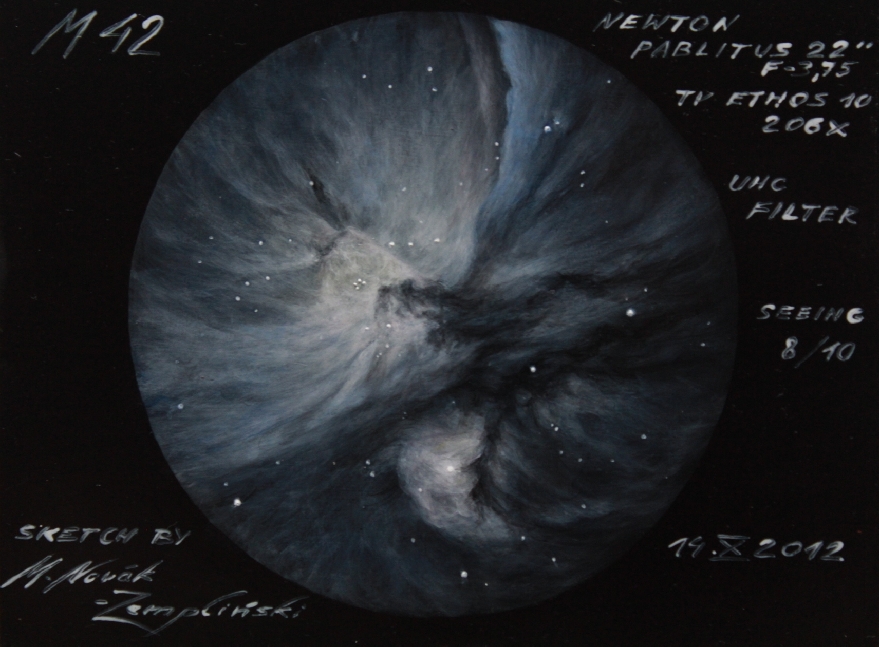
My name is Maksymilian Novak-Zemplinski and I’d like to show what I can see through my new baby Newtonian reflector Pablitus 22″.
Best regards
MNZ
Oject name: M42 The Orion Nebula
Object type: nebula
Location: Tulowice , Poland
Date: 14 October 2012
Media: Acrylic/oil on panel
Equipment: Newtonian reflector dob PABLITUS 22″ f-3,75, Tele Vue Ethos 10mm eyepiece, Astronomik UHC filter
Seeing: 8/10

Hi ASOD
Another watercolour I did during the InOMN event (International Observation of the Moon Night) but… during the daylight.
Object Name (2012 September 22 Moon)
Object Type (Daylight Moon)
Location (Néoules Provence France)
Date (2012 September 22 – 16hoo Local Time)
Media (graphite pencil for the moon, watercolour for the landscape)
We organize a special event for the InOMN (International Observation of the Moon Night).
21 of us attended this pleasant event organized by the local club “Polaris83”. We used 7 miscellaneous telescopes during the event.
I made two separate sketches, one with standard graphite pencil for the moon, the second one is a common watercolour I did of the local wild landscape. I scanned both paper and compile them together.
I used my 1000/102 Bresser refractor with a 40mm eyepiece to get a good contrast facing the bright background sky.
The compilation was done with the freeware software : Paint.Net
Conditions were perfect, the sun was hot here… !
Clear sky to you all
Michel Deconinck
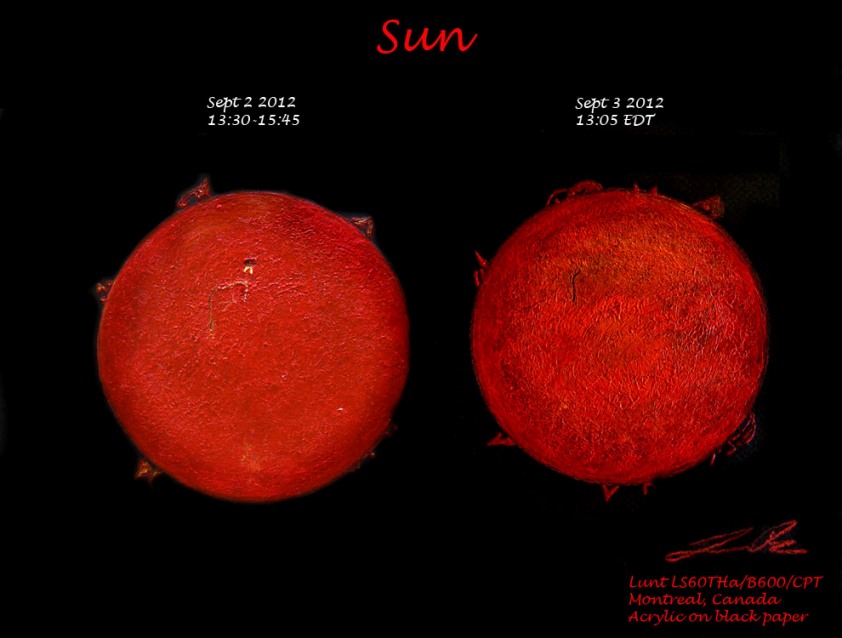
Object Name : Sun
Object Type : H alpha observation
Location : Montreal, Canada
Date : September 2 and 3
Media : Acrylic on black paper
Scope: Lunt LS60THa/B600|CPT on motorized EQ3 mount.
Our star put up a great show during 2 days. I was able to observe the «good hair day» of the sun for a total of nearly 5 hours. Many proeminences, which remained relatively stable throughout 48 hours, could be seen. The observation of September 2nd was interesting. I started the observation around 13:00 EDT keeping the magnification low (25-50X) to sketch the whole disk and the distribution of the proeminences. I kept an eye on AR 1560, which was facing earth. Around 14:00 EDT this region began to light up. Two bright flares (showed at the upper center lane of the first disk) were clearly visible and increased in brightness for the next 30 minutes. Then they faded away and by 15:00 EDT the phenomenon ended. I was glad to be able to capture this activity on my sketch.
The sketches were done on black Pastel Paper with HB pencil to record details of the proeminences. The disk was traced with a compass. Acrylic paint (red and yellow) was then used to reproduce the color seen in H alpha. The paint was layered with large and small brushes directly on the lines of the HB pencil. The two separate sketches were photographed and then assembled with Photoshop CS3. No color or contrast adjustment were done except for the background.
Jean Barbeau
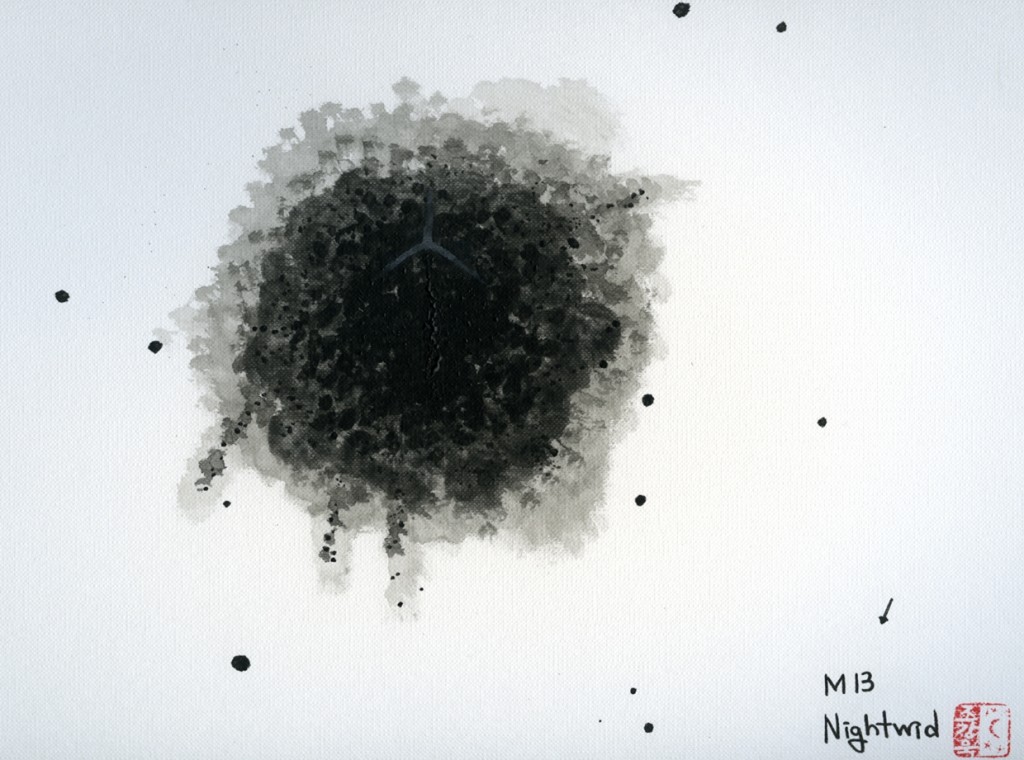
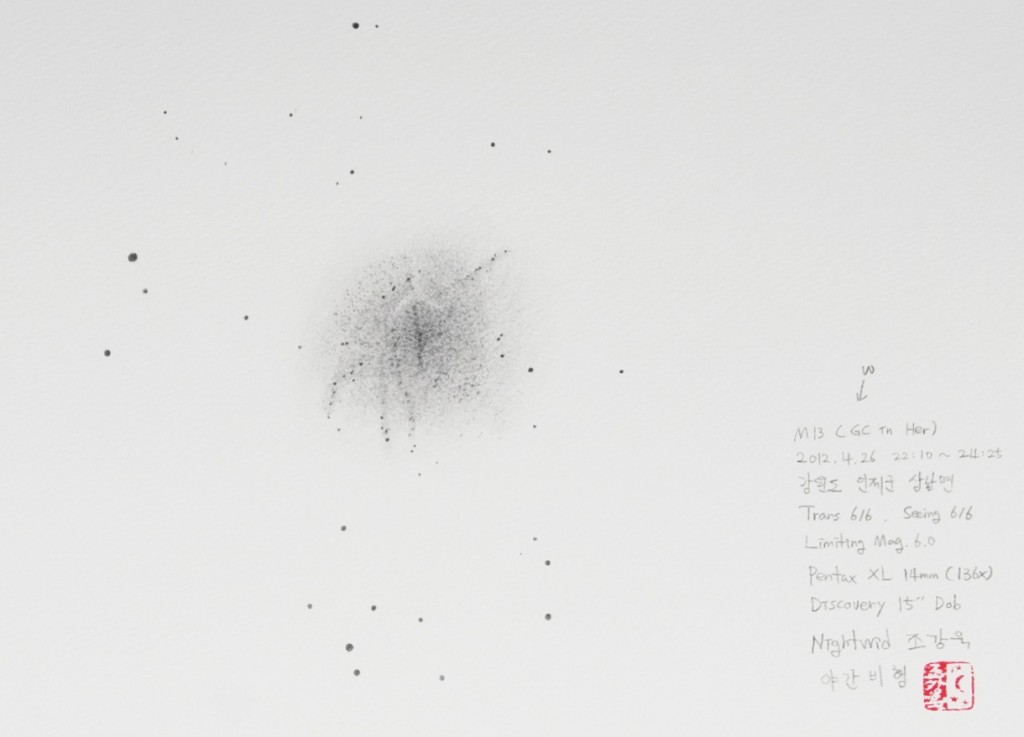
I saw the ‘Propeller’ in M13 under a good seeing condition.
Description
http://www.nightflight.or.kr/xe/files/attach/images/25489/802/057/34b6a07cb0a827ec613ab2e5188e9ee2.jpg
Equipment : Discovery 15″
Media : Sharp pencil
Location : Inje, S.Korea
After few days, I went to the national art gallery to see monochrome paintings.
Suddenly an inspiration flashed through my mind.
And I drew the M13 with acrylic & brush.
I love this tough painting than detailed sketch!
Nightwid 無雲